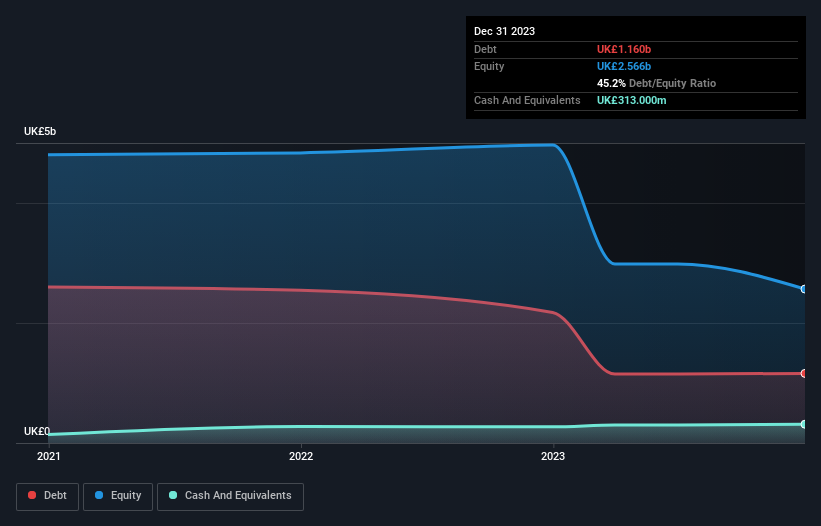David Iben put it well when he said, 'Volatility is not a risk we care about. What we care about is avoiding the permanent loss of capital.' So it might be obvious that you need to consider debt, when you think about how risky any given stock is, because too much debt can sink a company. Importantly, Dowlais Group plc (LON:DWL) does carry debt. But the more important question is: how much risk is that debt creating?
Why Does Debt Bring Risk?
Debt assists a business until the business has trouble paying it off, either with new capital or with free cash flow. If things get really bad, the lenders can take control of the business. While that is not too common, we often do see indebted companies permanently diluting shareholders because lenders force them to raise capital at a distressed price. Of course, plenty of companies use debt to fund growth, without any negative consequences. When we think about a company's use of debt, we first look at cash and debt together.
Check out our latest analysis for Dowlais Group
What Is Dowlais Group's Net Debt?
You can click the graphic below for the historical numbers, but it shows that Dowlais Group had UK£1.16b of debt in December 2023, down from UK£2.18b, one year before. However, it also had UK£313.0m in cash, and so its net debt is UK£847.0m.

How Healthy Is Dowlais Group's Balance Sheet?
Zooming in on the latest balance sheet data, we can see that Dowlais Group had liabilities of UK£1.45b due within 12 months and liabilities of UK£2.22b due beyond that. On the other hand, it had cash of UK£313.0m and UK£649.0m worth of receivables due within a year. So it has liabilities totalling UK£2.71b more than its cash and near-term receivables, combined.
The deficiency here weighs heavily on the UK£1.13b company itself, as if a child were struggling under the weight of an enormous back-pack full of books, his sports gear, and a trumpet. So we'd watch its balance sheet closely, without a doubt. At the end of the day, Dowlais Group would probably need a major re-capitalization if its creditors were to demand repayment. When analysing debt levels, the balance sheet is the obvious place to start. But it is future earnings, more than anything, that will determine Dowlais Group's ability to maintain a healthy balance sheet going forward. So if you're focused on the future you can check out this free report showing analyst profit forecasts.
In the last year Dowlais Group wasn't profitable at an EBIT level, but managed to grow its revenue by 5.9%, to UK£4.9b. We usually like to see faster growth from unprofitable companies, but each to their own.
Caveat Emptor
Over the last twelve months Dowlais Group produced an earnings before interest and tax (EBIT) loss. Indeed, it lost UK£52m at the EBIT level. Considering that alongside the liabilities mentioned above make us nervous about the company. It would need to improve its operations quickly for us to be interested in it. Not least because it had negative free cash flow of UK£56m over the last twelve months. That means it's on the risky side of things. There's no doubt that we learn most about debt from the balance sheet. But ultimately, every company can contain risks that exist outside of the balance sheet. To that end, you should be aware of the 1 warning sign we've spotted with Dowlais Group .
When all is said and done, sometimes its easier to focus on companies that don't even need debt. Readers can access a list of growth stocks with zero net debt 100% free, right now.
New: Manage All Your Stock Portfolios in One Place
We've created the ultimate portfolio companion for stock investors, and it's free.
• Connect an unlimited number of Portfolios and see your total in one currency
• Be alerted to new Warning Signs or Risks via email or mobile
• Track the Fair Value of your stocks
Have feedback on this article? Concerned about the content? Get in touch with us directly. Alternatively, email editorial-team (at) simplywallst.com.
This article by Simply Wall St is general in nature. We provide commentary based on historical data and analyst forecasts only using an unbiased methodology and our articles are not intended to be financial advice. It does not constitute a recommendation to buy or sell any stock, and does not take account of your objectives, or your financial situation. We aim to bring you long-term focused analysis driven by fundamental data. Note that our analysis may not factor in the latest price-sensitive company announcements or qualitative material. Simply Wall St has no position in any stocks mentioned.
About LSE:DWL
Dowlais Group
Manufactures and sells automotive parts in the United Kingdom, Rest of Europe, North America, South America, Asia, and Africa.
Good value with very low risk.
Market Insights
Community Narratives



